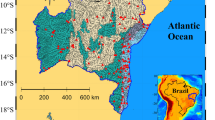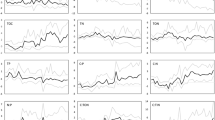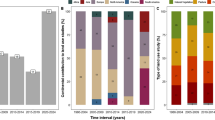Abstract
Consequences of anthropogenic climate change directly affect freshwater ecosystems and their aquatic biological communities. Diatoms are amongst the most sensitive organisms to hydric stress, making them good indicators of preceding hydrological conditions. We assume that river types with low runoff and associated high temperature and mineralization host the most tolerant diatoms to climate change. We performed a cluster analysis with reference sites throughout Spain, based on their physiographic and hydrological characteristics. We obtained seven end-groups spread in the three existing ecoregions, onto which we estimated the indicator diatom taxa (IndVal). Brackish and aerophilic diatom were indicator taxa in mineralized and low discharge rivers. We simulated the impact of climate change on the river types, to conclude that under the RCP 8.5, the most impacted of all types would be the mineralized rivers. We predict higher homogenization in the diatom assemblages’ composition, with higher proportion of planktonic taxa, and a potential increase of terrestrial and aerophilic diatoms, as the best adapted to the harsh conditions imposed by runoff reduction. Formulating clear predictions of climate change effects should rely on planned, long-term monitoring including accurate hydrological and biological data.





Similar content being viewed by others
Data availability
The datasets analysed during the current study are available from the corresponding author on reasonable request.
References
ACA, 2020. Estudi general de la demarcació, anàlisi d’impactes i pressions de l’activitat humana i anàlisi econòmica de l’ús de l’aigua a les masses d’aigua del districte de conca fluvial de Catalunya. Document IMPRESS 2019. Generalitat de Catalunya, Departament de Territori i Sostenibilitat. http://aca.gencat.cat/ca/plans-i-programes/pla-de-gestio/3r-cicle-de-planificacio-2022-2027/document-impress/index.html.
Almeida, S. F. P., C. Elias, J. Ferreira, E. Tornés, C. Puccinelli, F. Delmas, G. Dörflinger, G. Urbanič, S. Marcheggiani, J. Rosebery, L. Mancini & S. Sabater, 2014. Water quality assessment of rivers using diatom metrics across Mediterranean Europe: a methods intercalibration exercise. Science of the Total Environment 476–477: 768–776.
Álvarez, J., A. Sánchez & L. Quintas, 2004. SIMPA, a GRASS based tool for hydrological studies. In Proceedings of the FOSS/GRASS Users Conference, Bangkok.
Anderson, M. J., 2001. Permutation tests for univariate or multivariate analysis of variance and regression. Canadian Journal of Fisheries and Aquatic Sciences 58: 626–639.
Anderson MJ, Gorley RN, Clarke KR (2008) PERMANOVA+ for PRIMER. Guide to Software and Statistical Methods. PRIMER-E, Plymouth, UK.
Amigo, J., M. A. Rodríguez-Guitián, J. J. P. Honrado & P. Alves, 2017. The lowlands and midlands of Northwestern Atlantic Iberia. In Loidi, J. (ed), The vegetation of the Iberian Peninsula, plant and vegetation, 12. Springer, Cham: 191–250.
B-Béres, V., B. Tóthmérész, I. Bácsi, G. Borics, A. Abonyi, K. Tapolczai, F. Rimet, A. Bouchez, G. Várbíró & P. Török, 2019. Autumn drought drives functional diversity of benthic diatom assemblages of continental intermittent streams. Advances in Water Resources 126: 129–136.
Cantonati, M., N. Angeli, E. Bertuzzi, D. Spitale & H. Lange-Bertalot, 2012. Diatoms in springs of the Alps: spring types, environmental determinants, and substratum. Freshwater Science 31: 499–524.
Cantonati, M., M. G. Kelly & H. Lange-Bertalot, 2017. Freshwater benthic diatoms of Central Europe: over 800 common species used in ecological assessments. English edition with updated taxonomy and added species, Koeltz Botanical Books, Schmitten-Oberreifenberg:
Cañedo-Argüelles, M., K. S. Boersma, M. T. Bogan, J. D. Olden, I. Phillipsen, T. A. Schriever & D. A. Lytle, 2015. Dispersal strength determines meta-community structure in a dendritic riverine network. Journal of Biogeography 42: 778–790.
Capone, T. A. & J. A. Kushlan, 1991. Fish community structure in dry-season stream pools. Ecology 72: 983–992.
CEDEX, 2017. Evaluación del impacto del cambio climático en los recursos hídricos y sequías en España. Informe Técnico para el Ministerio de Agricultura y Pesca, Alimentación y Medio Ambiente, Secretaría de Estado de Medio Ambiente, Oficina Española de Cambio Climático. Tomo Único, clave CEDEX 42-407-1-001. Centro de Publicaciones, Secretaría General, Técnica del Ministerio de Fomento. http://www.cedex.es/CEDEX/LANG_CASTELLANO/ORGANISMO/CENTYLAB/CEH/Documentos_Descargas/EvaluacionimpactoCCsequiasEspana2017.htm.
Centis, B., M. Tolotti & N. Salmaso, 2010. Structure of the diatom community of the River Adige (North-Eastern Italy) along a hydrological gradient. Hydrobiologia 639: 37–42.
CHE, 2017. Análisis de presiones e impactos y evaluación del riesgo de incumplir los objetivos medioambientales de la Directiva Marco del Agua en aguas superficiales de la cuenca del Ebro. Documento IMPRESS 2015. Confederación Hidrográfica del Ebro, Área de Calidad de las Aguas. http://www.chebro.es/contenido.visualizar.do?idContenido=22071&idMenu=4041.
Colls, M., X. Timoner, C. Font, S. Sabater & V. Acuña, 2019. Effects of duration, frequency, and severity of the non-flow period on stream biofilm metabolism. Ecosystems 22: 1393–1405.
Death, R. G., I. C. Fuller & M. G. Macklin, 2015. Resetting the river template: the potential for climate-related extreme floods to transform river geomorphology and ecology. Freshwater Biology 60: 2477–2496.
Delgado, C., L. Ector, M. H. Novais, S. Blanco, L. Hoffmann & I. Pardo, 2013. Epilithic diatoms of springs and spring-fed streams in Majorca Island (Spain)with the description of a new diatom species Cymbopleura margalefii sp. nov. Fottea 13: 87–104.
Döll, P. & J. Zhang, 2010. Impact of climate change on freshwater ecosystems: a global-scale analysis of ecologically relevant river flow alterations. Hydrology and Earth System Sciences 14: 783–799.
Dong, X. Y., B. Li, F. Z. He, Y. Gu, M. Q. Sun, H. M. Zhang, L. Tan, W. **ao, S. R. Liu & Q. H. Cai, 2016. Flow directionality, mountain barriers and functional traits determine diatom metacommunity structuring of high mountain streams. Scientific Reports 6: 24711.
Dufrêne, M. & P. Legendre, 1997. Species assemblages and indicator species: the need for a flexible asymmetrical approach. Ecological Monographs 67: 345–366.
Dudgeon, D., A. H. Arthington, M. O. Gessner, Z.-I. Kawabata, D. J. Knowler, C. Lévêque, R. J. Naiman, A.-H. Prieur-Richard, D. Soto, M. L. J. Stiassny & C. A. Sullivan, 2006. Freshwater biodiversity: importance, threats, status and conservation challenges. Biological Reviews 81: 163–182.
European Commission, 2000. Directive 2000/60/EC of The European Parliament and of the Council of 23 October 2000-establishing a framework for community action in the field of water policy. Official Journal of the European Communities L327: 1–73.
European Commission, 2003. Common implementation strategy for the Water Framework Directive (2000/60/EC), Working Group REFCON, guidance document no. 10, rivers and lakes – tipology, reference conditions and classification systems.
Falasco, E., E. Piano & F. Bona, 2016. Diatom flora in Mediterranean streams: flow intermittency threatens endangered species. Biodiversity and Conservation 25: 2965–2986.
Falasco, E., E. Piano, A. Doretto, S. Fenoglio & F. Bona, 2018. Lentification in Alpine rivers: patterns of diatom assemblages and functional traits. Aquatic Sciences 80: 36.
Falasco, E., D. Alberto, S. Fenoglio, E. Piano, & F. Bona, 2020. Supraseasonal drought in an Alpine river: effects on benthic primary production and diatom community. https://doi.org/10.4081/jlimnol.2020.1933.
Falasco, E., F. Bona, A. M. Risso & E. Piano, 2021. Hydrological intermittency drives diversity decline and functional homogenization in benthic diatom communities. Science of the Total Environment 762: 143090.
Feio, M. J., F. C. Aguiar, S. F. Almeida, J. Ferreira, M. T. Ferreira, C. Elias, S. R. Serra, A. Buffagni, J. Cambra, C. Chauvin, F. Delmas, G. Dörflinger, S. Erba, N. Flor, M. Ferréol, M. Germ, L. Mancini, P. Manolaki, S. Marcheggiani, M. R. Minciardi, A. Munné, E. Papastergiadou, N. Prat, C. Puccinelli, J. Rosebery, S. Sabater, S. Ciadamidaro, E. Tornés, I. Tziortzis, G. Urbanič & C. Vieira, 2013. Least disturbed condition for European Mediterranean rivers. Science of the Total Environment 476–477: 745–756.
Gartzia de Bikuna, B., E. Lopez, J. M. Leonardo, J. Arrate, A. Martinez & A. Manzanos, 2015. Development of a multimetric benthic macroinvertebrate index for assessing the ecological condition of Basque streams (north of Spain). Fundamental and Applied Limnology 187: 21–32.
Gasith, A. & V. H. Resh, 1999. Streams in Mediterranean climate regions: abiotic influences and biotic responses to predictable seasonal events. Annual Review of Ecology and Systematics 30: 51–81.
Gudmundsson, L., J. Boulange, H. X. Do, S. N. Gosling, M. G. Grillakis, A. G. Koutroulis, M. Leonard, J. Liu, H. Müller Schmied, L. Papadimitriou, Y. Pokhrel, S. I. Seneviratne, Y. Satoh, W. Thiery, S. Westra, X. Zhang & F. Zhao, 2021. Globally observed trends in mean and extreme river flow attributed to climate change. Science 371: 1159–1162.
Hansen, M. J. & C. W. Ramm, 1994. Persistence and stability of fish community structure in a southwest New York stream. American Midland Naturalist 132: 52–67.
Hayashi, M., 2004. Temperature-electrical conductivity relation of water for environmental monitoring and geophysical data inversion. Environmental Monitoring and Assessment 96: 119–128.
Heudre, D., C. E. Wetzel, B. Van de Vijver, L. Moreau & L. Ector, 2020. Brackish diatom species (Bacillariophyta) from rivers of Rhin-Meuse basin in France. Botany Letters 168: 56–84.
IPCC, 2021. Climate Change 2021: The Physical Science Basis. Contribution of Working Group I to the Sixth Assessment Report of the Intergovernmental Panel on Climate Change. Cambridge University Press, Cambridge, New York. In Press.
Jaramillo, F. & G. Destouni, 2015. Local flow regulation and irrigation raise global human water consumption and footprint. Science 350: 1248–1251.
Kelly, M. G., A. Cazaubon, E. Coring, A. Dell’Uomo, L. Ector, B. Goldsmith, H. Guasch, J. Hürlimann, A. Jarlman, B. Kawecka, J. Kwandrans, R. Laugaste, E.-A. Lindstrøm, M. Leitao, P. Marvan, J. Padisák, E. Pipp, J. Prygiel, E. Rott, S. Sabater, H. Van Dam & J. Vizinet, 1998. Recommendations for the routine sampling of diatoms for water quality assessments in Europe. Journal of Applied Phycology 10: 215–224.
Krammer K. & H. Lange-Bertalot, 1991a. Bacillariophyceae 3. Teil: Centrales, Fragilariaceae, Eunotiaceae. In Ettl H., J. Gerloff, H. Heynig & D. Mollenhauer, (eds) Süsswasserflora von Mitteleuropa, 2. Gustav Fischer Verlag, Stuttgart, Germany.
Krammer, K. & H. Lange-Bertalot, 1991b. Bacillariophyceae 4. Teil: Achnanthaceae, Kritische Ergänzungen zu Navicula (Lineolatae) und Gomphonema. In Ettl H., J. Gerloff, H. Heynig & D. Mollenhauer (eds), Süsswasserflora von Mitteleuropa, 2. Gustav Fischer Verlag, Stuttgart, Germany.
Krammer K. & H. Lange-Bertalot, 1997a. Bacillariophyceae 1. Teil: Naviculaceae. In Ettl H., J. Gerloff, H. Heynig, D. Mollenhauer (eds) Süsswasserflora von Mitteleuropa, 2. Gustav Fischer Verlag, Jena, Germany.
Krammer, K. & H. Lange-Bertalot, 1997b. Bacillariophyceae 2. Teil: Bacillariaceae, Epithemiaceae, Surirellaceae. In Ettl H., J. Gerloff, H. Heynig & D. Mollenhauer (eds), Süsswasserflora von Mitteleuropa, 2. Gustav Fischer Verlag, Jena, Germany.
Liu, J., J. Soininen, B. P. Han & S. A. Declerck, 2013. Effects of connectivity, dispersal directionality and functional traits on the metacommunity structure of river benthic diatoms. Journal of Biogeography 40: 2238–2248.
MAGRAMA, 2013. Protocolo de muestreo y laboratorio de flora acuática (organismos fitobentónicos) en ríos. Código ML-R-D-2013. Centro de Publicaciones, Secretaría General Técnica del Ministerio de Agricultura, Alimentación y Medio Ambiente. https://www.miteco.gob.es/es/agua/temas/estado-y-calidad-de-las-aguas/ML-R-D-2013-Muestreo%20y%20laboratorio_Flora%20acu%C3%A1tica%20Fitobentos_R%C3%ADos%2024_05_2013_tcm30-175285.pdf
Messager, M. L., B. Lehner, C. Cockburn, N. Lamouroux, H. Pella, T. Snelder, K. Tockner, T. Trautmann, C. Watt & T. Datry, 2021. Global prevalence of non-perennial rivers and streams. Nature 594: 391–397.
Novais, M. H., M. M. Morais, J. Rosado, L. S. Dias, L. Hoffmann & L. Ector, 2014. Diatoms of temporary and permanent watercourses in Southern Europe (Portugal). River Research and Applications 30: 1216–1232.
Pan, Y. D., R. J. Stevenson, B. H. Hill, P. R. Kaufmann & A. T. Herlihy, 1999. Spatial patterns and ecological determinants of benthic algal assemblages in Mid-Atlantic streams, USA. Journal of Phycology 35: 460–468.
Petrovic, M., A. Ginebreda, V. Acuña, R. J. Batalla, A. Elosegi, H. Guasch, M. López de Alda, R. Marcé, I. Muñoz, A. Navarro-Ortega, E. Navarro, D. Vericat, S. Sabater & D. Barceló, 2011. Combined scenarios of chemical and ecological quality under water scarcity in Mediterranean rivers. Trends in Analytical Chemistry 30: 1269–1278.
Petsch, D. K., 2016. Causes and consequences of biotic homogenization in freshwater ecosystems. International Review of Hydrobiology 101: 113–122.
QGIS Development Team, 2020. QGIS Geographic Information System. Open Source Geospatial Foundation Project. http://qgis.osgeo.org.
R Core Team, 2020. R: a language and environment for statistical computing. R Foundation for Statistical Computing, Vienna, Austria. http://www.R-project.org/.
Ros, M. D., J. P. Marín-Murcia & M. Aboal, 2009. Biodiversity of diatom assemblages in a Mediterranean semiarid stream: implications for conservation. Marine and Freshwater Research 60: 14–24.
Sabater, S., 2008. Alterations of the global water cycle and their effects on river structure, function and services. Freshwater Reviews 1: 75–88.
Sabater, S., F. Bregoli, V. Acuña, D. Barceló, A. Elosegi, A. Ginebreda, R. Marcé, I. Muñoz, L. Sabater-Liesa & V. Ferreira, 2018. Effects of human-driven water stress on river ecosystems: a meta-analysis. Scientific Reports 8: 11462.
Sabater S., A. Elosegi, M. J. Feio, R. Gómez, M. A. S. Graça, I. Muñoz, I. Pardo & A. M. Romaní, 2022. In Tockner, K., Ch. Zarfl & C. T. Robinson (eds), The Iberian Rivers. In: Rivers of Europe. Academic Press, 2nd Edition: 181–224.
Stoddard, J. L., D. P. Larsen, C. P. Hawkins, R. K. Johnson & R. H. Norris, 2006. Setting expectations for the ecological condition of streams: the concept of reference condition. Ecological Applications 16: 1267–1276.
Stubbington, R., J. England, P. J. Wood & C. E. Sefton, 2017. Temporary streams in temperate zones: recognizing, monitoring and restoring transitional aquatic-terrestrial ecosystems. Wiley Interdisciplinary Reviews Water 4: e1223.
Tornés, E. & A. Ruhí, 2013. Flow intermittency decreases nestedness and specialisation of diatom communities in Mediterranean rivers. Freshwater Biology 58: 2555–2566.
Tornés, E., M. Leira & S. Sabater, 2012. Is the biological classification of benthic diatom communities concordant with ecotypes? Hydrobiologia 695: 43–55.
Tornés, E., M. Colls, V. Acuña & S. Sabater, 2021. Duration of water flow interruption drives the structure and functional diversity of stream benthic diatoms. Science of the Total Environment 770: 144675.
Toro, M., S. Robles, I. Tejero, E. Cristóbal, S. Velasco, J. R. Sánchez & Pujante A., 2009. Bases ecológicas preliminares para la conservación de los tipos de hábitat de interés comunitario en España. Ministerio de Medio Ambiente, y Medio Rural y Marino, Madrid.
TRAGSATEC, 2020. Estudio, validación y selección final de estaciones de referencia en ríos. Informe REFCON. Grupo TRAGSA. Ministerio para la Transición Ecológica y el Reto Demográfico, Madrid.
Wallin M, Wiederholm T, Johnson RK (2003). Guidance on establishing reference conditions and ecological status class boundaries for inland surface waters. Common Implementation Strategy Working Group 2.3 – REFCOND, 2.
Wohl, E. E., 2010. Mountain Rivers Revisited, Water Resources Monograph, 19, American Geophysical Union, Washington, DC:
Zimmer, M. A., K. E. Kaiser, J. R. Blaszczak, S. C. Zipper, J. C. Hammond, K. M. Fritz, K. H. Costigan, J. Hosen, S. E. Godsey, G. H. Allen, S. Kampf, R. M. Burrows, C. A. Krabbenhoft, W. Dodds, R. Hale, J. D. Olden, M. Shanafield, A. G. DelVecchia, A. S. Ward, M. C. Mims, T. Datry, M. T. Bogan, K. S. Boersma, M. H. Busch, C. N. Jones, A. J. Burgin & D. C. Allen, 2020. Zero or not? Causes and consequences of zero-flow stream gage readings. Wiley Interdisciplinary Reviews Water 7: e1436.
Funding
This research was funded by the project “Technical service for monitoring reference stations and obtaining the baseline to assess alterations due to climate change and atmospheric pollution. Current situation (21.803-0985/0421)” of the Spanish Ministry of Ecological Transition—DG Water.
Author information
Authors and Affiliations
Corresponding author
Ethics declarations
Conflict of interest
The authors declare no conflict of interest.
Additional information
Handling Editor: Judit Padisák
Publisher's Note
Springer Nature remains neutral with regard to jurisdictional claims in published maps and institutional affiliations.
Supplementary Information
Below is the link to the electronic supplementary material.
Rights and permissions
About this article
Cite this article
Tornés, E., Alández-Rodríguez, J., Corrochano, A. et al. Impacts of climate change on stream benthic diatoms—a nation-wide perspective of reference conditions. Hydrobiologia 849, 1821–1837 (2022). https://doi.org/10.1007/s10750-022-04829-5
Received:
Revised:
Accepted:
Published:
Issue Date:
DOI: https://doi.org/10.1007/s10750-022-04829-5




